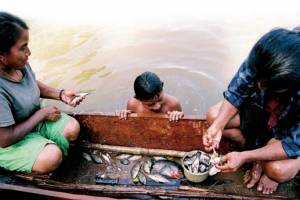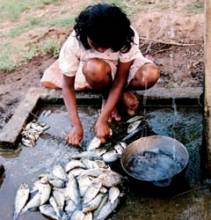Goals
- Ensure active participation in safeguarding and transmitting Mayangna knowledge and the community’s unique ecological, social and cultural relationship with the natural environment.
- Educate the scientific community and the general public on Mayangna living heritage and the key role that Mayangna indigenous knowledge plays in sustainable resource use and biodiversity management of the BOSAWAS Reserve.
- Develop and introduce innovative pedagogical materials on Mayangna local knowledge and living heritage into the school curriculum in BOSAWAS and eventually elsewhere in Nicaragua.
The BOSAWAS Biosphere reserve in north-central Nicaragua lies at heart of the Mesoamerican Biological Corridor and is home to numerous rare and endangered species. The indigenous Mayangna (or Sumu) people have lived in this bio-diverse territory for hundreds of years. Over time, they have developed extensive knowledge of the local flora and fauna and have shaped the biological system through their cultural practices. However, a rapidly advancing agricultural frontier, the increasing contamination of watercourses originating outside the reserve, the illegal logging, as well as the trade of endangered animal and plant species today, threatens these intertwined biological and cultural systems.
A UNESCO Local and Indigenous Knowledge Systems (LINKS) project, carried out with the support of the inhabitants of the Lakus River (one of the five Mayangna groups in BOSAWAS), had two interrelated objectives:
- To ensure that the knowledge possessed by the Mayangna, as well as their unique ecological, social and cultural relationship with the natural environment, were recognized and incorporated into the design and implementation of resource management processes of the BOSAWAS Biosphere Reserve; and
- To develop materials on local knowledge and living heritage in the Mayangna language and introduce them in the school curriculum in BOSAWAS.
Documentation of the BOSAWAS Reserve
In a first step, a cooperative project between the Mayangna community and the International Center for Tropical Ecology (ICTE) at the University of Missouri Saint Louis (USA), was carried out, which documented the animals and fauna of the reserve as well as the living heritage related to the latter. Interviews and interactive assemblies led to the collection of the Mayangna names of fish, turtles and fauna, along with knowledge and know-how of their natural history, harvesting techniques, related legends and myths among other things. A photo library was compiled using this data that documented thirty taxa of fish and six turtles—the two important food sources in the reserve and a vital part of the Mayangna way of life. In addition, the equivalent scientific terms for these taxa, as well as those in the Miskitu language and local spoken Spanish were matched to the Mayangna words. This formed part of a broader endeavour, where the names of 787 plants and animals were collected and organised into nineteen Mayangna categories.
Book on ‘Mayangna Knowledge on the Coexistence of Man and Nature: Fish and Turtles’
The efforts of the documentation resulted in the publication of a two-volume book (published in both Mayangna and Spanish), titled ‘Mayangna Knowledge on the Coexistence of Man and Nature: Fish and Turtles’. This book weaves together empirical observations on behaviour, habitat, reproduction and migration patterns, with commentaries on story-sharing, harvesting and sustainability know-how, as well as cosmological reflections on human-animal relations and master spirits.
In the book, Mayangna knowledge is presented in the words of the knowledge holders themselves along with the current scientific data. The science-based information does not pass judgement on what the Mayangna say, and vice-versa. To facilitate mutual understanding and dialogue between both, the Mayangna and scientific knowledge holders, the two sets of information are juxtaposed, encouraging learners to reflect on their convergence and/or divergence.
Integrating Resource Material in Formal Education System
In the next phase of the project, the contents of the book were integrated into the Mayangna formal education system. Pedagogical materials were developed to support the transmission of Mayangna knowledge, culture and language in the classroom and to encourage and stimulate interactions and discussions between students, their families and their larger communities, about the value of this traditional knowledge in the lives of the contemporary Mayangna people. The materials were designed through a collaborative and consultative methodology, which engaged a wide range of Mayangna experts, teachers, students, leaders, parents and community members. Additionally, efforts were also made to raise awareness about the importance of local knowledge for identity formation and community cohesion, and the benefits of integrating Mayangna living heritage into the classroom.
The project culminated in early 2016 when the Mayangna community, together with Nicaragua’s National Commission for UNESCO, launched preschool and 3rd grade pedagogical materials, published both in both Mayangna and Spanish. These materials were co-written and co-designed by Mayangna education professionals and in accordance with the current curriculum of the Ministry of Education. An official event marking the occasion was held at the Escuela Normal in Matagalpa, Nicaragua and was followed by a three-day capacity-building workshop with the participation of almost 100 Mayangna teachers, supervisors and Ministry of Education staff and officials.
The preschool and 3rd grade materials (the latter titled ‘People, Culture, Nature’) both comprise a teacher’s manual and a student’s workbook. In addition, BOSAWAS fish cards and posters were developed for the preschool level. There are methodological suggestions in the teachers’ manuals, structured along different axes relevant to Mayangna living heritage. Within each of these, various games and activities have been curated that offer children an opportunity to enjoy learning, while simultaneously strengthening the customs, traditions and knowledge about Mayangna living heritage, particularly which related to fish and turtles. Teachers using these manuals are also encouraged to integrate the participation of a heritage bearer into their lessons, as a means of facilitating the transmission and safeguarding of ancestral knowledge.
Project Outputs
- The Book titled: ‘Mayangna Knowledge on the Coexistence of Man and Nature: Fish and Turtles’ was published in two volumes. See the book brochure available in Spanish and Mayangna
- Educational Materials developed at the preschool and 3rd grade levels, in both Spanish and Mayangna, consisting of teacher manuals, student workbooks, and preschool posters and fish cards.
- A three-day capacity-building workshop for teachers, supervisors, and Ministry of Education staff and officials was organized.
Impact
As an outcome of this project, the living heritage of the Mayangna community was successfully linked with the early school curriculum, through dedicated educational materials. The integration of Mayangna indigenous language, living heritage and knowledge of biodiversity into the classroom helped in reinforcing the meaningfulness and relevance of school for Mayangna youth and built community self-esteem. It also improved the quality of schooling by making the lessons more significant and interesting to the students.
The book that was developed during this project aimed to create new opportunities for safeguarding and reinforcing the transmission of indigenous knowledge in both the communities and the classrooms. It also provides a foundation for enhancing biodiversity management by bringing indigenous knowledge on board alongside science, and by reinforcing recognition of indigenous peoples as resource managers in their own right.
Moreover, by involving practioners and knowledge bearers in the teaching of the materials, the project has strengthened the safeguarding of intangible cultural heritage, as well as integrated sustainability principles into education and learning environments. By bringing recognition to the Mayangna’s traditional knowledge and practices, integrating it into the school curriculum, and by having them demonstrate their influential role in natural resource management, the project essentially aimed to confer on the Mayagna people, an increasingly prominent role in the sustainable development of the region.
“These classroom materials strengthen our children, they open up the knowledge of indigenous peoples. We value that they are in accordance with our Mayangna reality, they speak of and reflect customs and traditions that must be further reinforced.”
- Mayangna community member

© Paule Gros and Menuka Scetbon-didi

© Menuka Scetbon-Didi
See the main page for this project here.
The content of the projects and documents referenced in this platform do not imply the expression of any opinion whatsoever on the part of UNESCO, including designations employed concerning the legal status of any country, territory, city or area or of its authorities or concerning the delimitation of its frontiers or boundaries.
